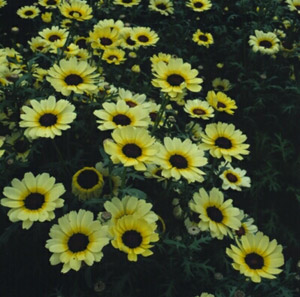New Account | Seed Mix |
Gift Certificates |AAS Winners |
Gardening Products
SEEDS: Unusual | Annuals | Perennials | Vegetables | Herbs | Trees
Chrysanthemum Seed ( Perennial/Annual )
Requires well-drained soil. Pinch all at least 2-3 times
through early summer (the end of July in the South and
Southwest) for more compact and more floriferous plants. Plants
are more likely to survive in cold climates if stems are left
standing over winter.
Perennial varieties: Prune hard in spring. Divide every 1-2 years in spring to keep plants vigorous.
Perennial varieties: Prune hard in spring. Divide every 1-2 years in spring to keep plants vigorous.

JB157 Robinson's Rose ( Chrysanthemum Coccineum )
If you enjoy cutting flowers for arrangements, you will want to grow this Chrysanthemum! This is a wonderful perennial addition to the landscape, and it readily grows from flower seeds. The foliage is delicate and fern-like, and the 2 1/2 inch blooms are a lovely shades of pink and rose. There are different scientific names for this Painted Daisy: Tanacetum coccineum and Pyrethrum coccineum can both be used in addition to Chrysanthemum coccineum. Growing Painted Daisies from flower seeds is a rewarding way to fill your landscape with the lovely flowers! Grows about 18 inches tall, well suited for zones 3-8.
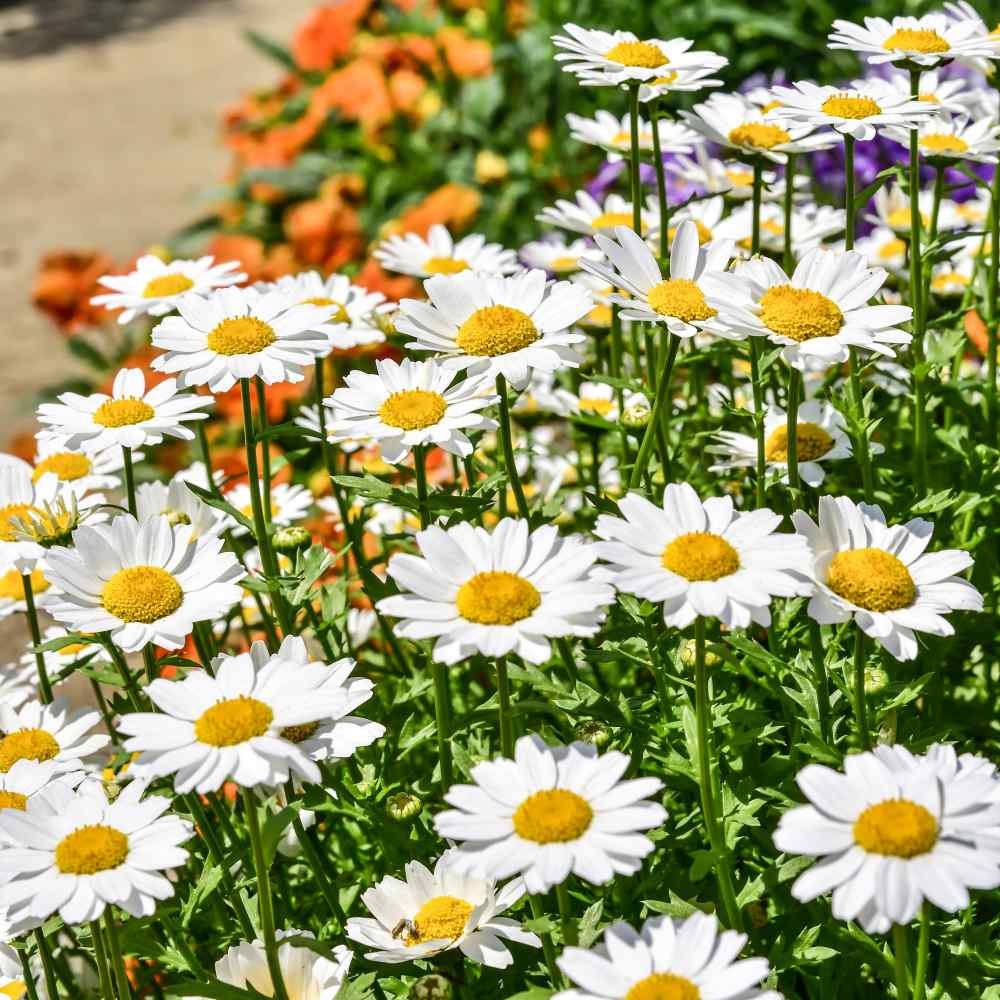
JB169 Creeping Daisy ( Chrysanthemum Paludosum )
Easy to grow from flower seeds and quick to flower with a spreading habit, these little Creeping Daisies are a great filler for garden beds, rock gardens, containers, and window boxes. Chrysanthemum Paludosum seeds produce a compact, low growing flowering plant that has 1 1/2 inch flowers. Deadheading and pinching help maintain the compact growth. Creeping Daisy plants typically only grow about 6 - 12 inches tall, but they will spread to 15 inches in no time. Chrysanthemum Paludosum does not waste anytime. After being sown from flower seeds, it blooms in about 12 weeks! Creeping Daisy ground cover is perfect for sunny sites and it's usually resistant to deer.
Butterflies love to visit these sweet little flowers! Chrysanthemums can be liberal self-sowers, and Creeping Daisy will drop its own flower seeds giving you brand new Creeping Daisy plants the following year. Creeping Daisy is technically a perennial, but only in frost free zones 9 and 10.
Creeping Daisy seeds can be sown directly outside in the spring after frost season is over. In a prepared seedbed that is weed free, so the flower seeds about 12 inches apart and press the Chrysanthemum seeds into the soil. Keep the seeds moist until germination occurs. Creeping Daisy care includes an application of all purpose fertilizer each month throughout the growing season and pinching back spent flowers to encourage continued blooming.
Butterflies love to visit these sweet little flowers! Chrysanthemums can be liberal self-sowers, and Creeping Daisy will drop its own flower seeds giving you brand new Creeping Daisy plants the following year. Creeping Daisy is technically a perennial, but only in frost free zones 9 and 10.
Creeping Daisy seeds can be sown directly outside in the spring after frost season is over. In a prepared seedbed that is weed free, so the flower seeds about 12 inches apart and press the Chrysanthemum seeds into the soil. Keep the seeds moist until germination occurs. Creeping Daisy care includes an application of all purpose fertilizer each month throughout the growing season and pinching back spent flowers to encourage continued blooming.
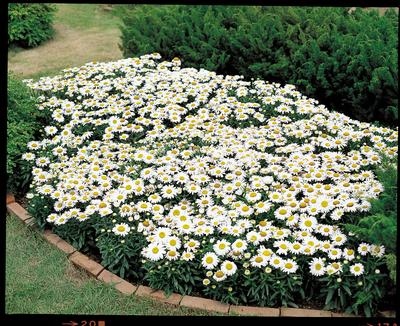
SF362 Snow Lady ( Chrysanthemum x superbum )
1988 AAS Flower Winner. This perennial is commonly grown as an annual. Snow Lady is the earliest Shasta daisy to flower on a dwarf, petite plant. It will continue to bloom all summer. A profusion of large flowers on low, mounded plants, ideal for garden's edge. Attractive in butterfly gardens, cutting gardens or combined with other perennials or annuals. Remove faded flowers for continued bloom and best appearance. Grows about 10-12 inches tall and speards to about 15 inches.
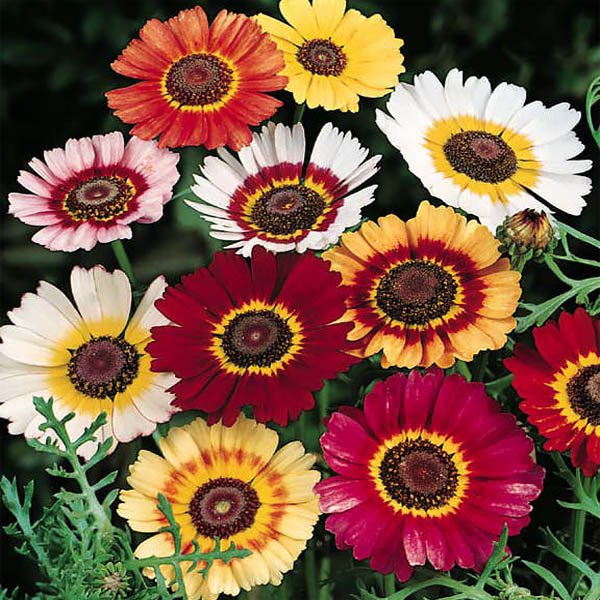
JB130 Rainbow Mix ( Chrysanthemum Carinatum )
You will want to start these Chrysanthemum seeds and attract attention to your garden! The Rainbow Mix offers colors of purple, orange, scarlet, rose, salmon, yellow and white and puts on a dazzling display of color. Growing only 12 to 18 inches tall, they fit well in any flower bed.
Painted Daisies also make great cut flowers so that you can bring the color indoors! Some flower seeds can be difficult to germinate; however, this is not the case with Chrysanthemum flower seed. Grow Chrysanthemum Carinatum plants in a rich, well-drained, evenly moist soil and in full sun. Good drainage during the winter is essential. Hardiness Zone : 3b-9a.
Painted Daisies also make great cut flowers so that you can bring the color indoors! Some flower seeds can be difficult to germinate; however, this is not the case with Chrysanthemum flower seed. Grow Chrysanthemum Carinatum plants in a rich, well-drained, evenly moist soil and in full sun. Good drainage during the winter is essential. Hardiness Zone : 3b-9a.
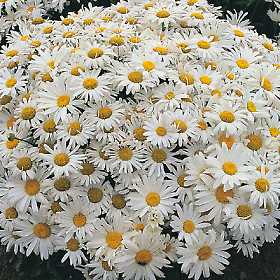
LET935 Marconi Shasta Daisy ( Leucanthemum marconi )
Marconi grows to 3 feet tall and has double white flowers ( 2 to 4 inches
across) and gold centers. Clump forming perennial. Flowers begin blooming in May, with largest show around early June, then continue sporadically until frost. Flower stalks are 2 to 4feet tall making these splendid in borders. Shasta Daisies make excellent cut
flowers, as they are long lasting and hold form and color well. Grows 36" tall.
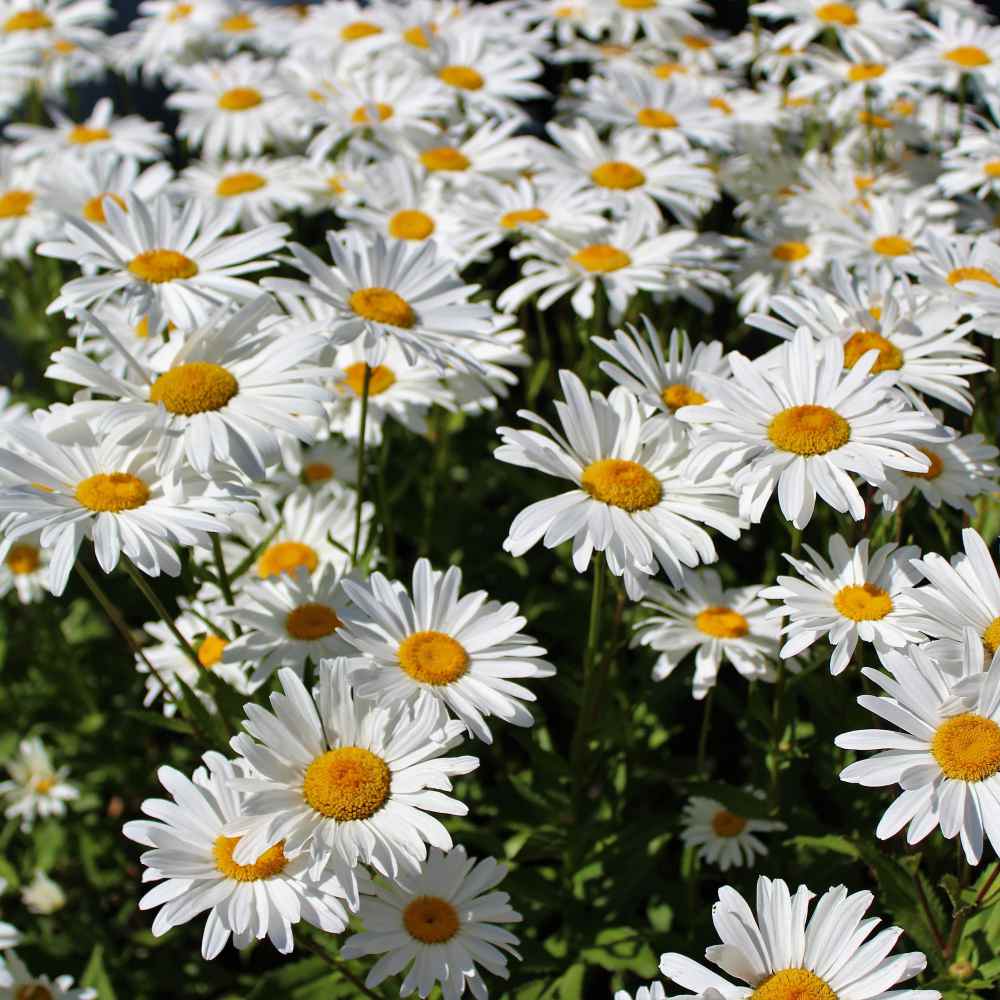
1A458 Shasta Daisy ( Chrysanthemum maximum )
Start seeds to grow this old-fashioned favorite! Chrysanthemum Maximum Shasta Daisy is a mainstay in the perennial flower garden with its large white blooms and yellow centers. Shasta Daisy is a very popular wild flower that will grow in all regions of North America. Chrysanthemums are very easy to establish from flower seeds, and Shasta Daisy flowers are great for cutting and the butterflies love them. Chrysanthemum likes to grow in full sun and well-drained soils. To prolong the bloom pick off flowers as soon as they fade. To prevent overcrowding, divide Shasta Daisy plants after three or four years of flowering.
Shasta Daisy plants are ideal for a wild flower garden's edge or are attractive in butterfly gardens or combined with other perennials or annuals. For cooler climates with short growing seasons, start the Chrysanthemum Daisy seeds indoor 6 - 8 weeks before frost season is over. For warmer climates, sow the Shasta Daisy seeds directly outdoors into prepared beds in the spring after danger of frost has passed. Sow the wild flower seed on the surface and keep moist. Shasta Daisy flowers will not bloom the first year, but grow slowly to get established. It will then be a prolific bloomer in successive years. Shastas are one of the best daisies to grow from wild flower seed! Grows about 32 inches tall. A perennial for zones 3-9.
Shasta Daisy plants are ideal for a wild flower garden's edge or are attractive in butterfly gardens or combined with other perennials or annuals. For cooler climates with short growing seasons, start the Chrysanthemum Daisy seeds indoor 6 - 8 weeks before frost season is over. For warmer climates, sow the Shasta Daisy seeds directly outdoors into prepared beds in the spring after danger of frost has passed. Sow the wild flower seed on the surface and keep moist. Shasta Daisy flowers will not bloom the first year, but grow slowly to get established. It will then be a prolific bloomer in successive years. Shastas are one of the best daisies to grow from wild flower seed! Grows about 32 inches tall. A perennial for zones 3-9.
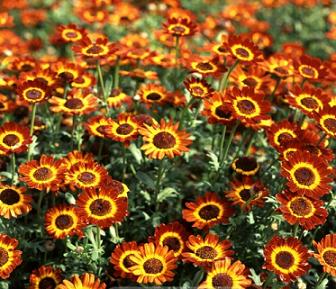
IP326 German Flag ( Chrysanthemum segetum )
A very easy to grow daisy type. The single flowers have a wonderful contrasting color that has a dark purple heart, with a bright yellow border and a warm red outer wreath giving it the unique look among chrysanthemums. Finely incised leaves and an abundance of flowers, make this a flower bed must.
Also known as Corn Marigold, grows about 15" tall, blooms in 12 weeks from seed.
Also known as Corn Marigold, grows about 15" tall, blooms in 12 weeks from seed.
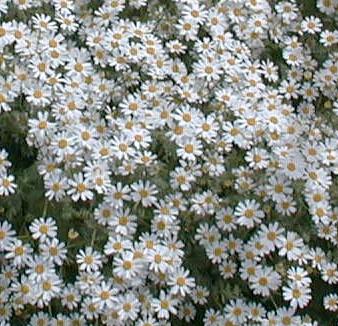
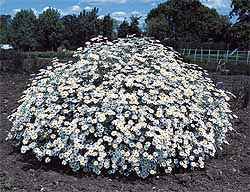
JB095 Jackpot Tansy ( Tanacetum niveum )
Sensational variety from England. Soft downy woolly grey leaves are soon overwhelmed by a shroud of white flowers, so much so that you almost cannot see the leaves. Has the same insect-repelling properties as other tansies. Not invasive.
Bright white, 1/4 to 1/2 inch wide, daisy-like flowers with a yellow center are produced in profusion from early through midsummer. Jackpot is extremely floriferous, up to 1000 blooms are produced at a time! If cut back after flowering, it may rebloom in the fall.
The aromatic, silvery-green, ferny foliage forms a nice mound similar to a chrysanthemum. The first year, it will grow to an approximate height of 18 inches. The second year, this vigorous grower may double in size.
Jackpot combines well with just about everything else in the garden. It is wonderful in mixed container plantings and can also be used as a cut flower.
A hardy perennial for zones 5-9.
Bright white, 1/4 to 1/2 inch wide, daisy-like flowers with a yellow center are produced in profusion from early through midsummer. Jackpot is extremely floriferous, up to 1000 blooms are produced at a time! If cut back after flowering, it may rebloom in the fall.
The aromatic, silvery-green, ferny foliage forms a nice mound similar to a chrysanthemum. The first year, it will grow to an approximate height of 18 inches. The second year, this vigorous grower may double in size.
Jackpot combines well with just about everything else in the garden. It is wonderful in mixed container plantings and can also be used as a cut flower.
A hardy perennial for zones 5-9.
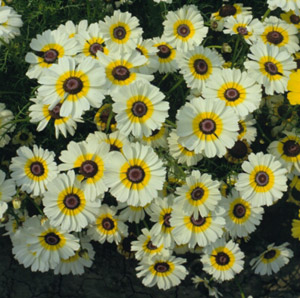
NB53 Polar Star ( Chrysanthemum carinatum )
Tetraploid, large tricolor flowers, white with yellow ring and dark center, smashing country garden plant, grows about 24" tall, blooms in 15 weeks from seed. Annual
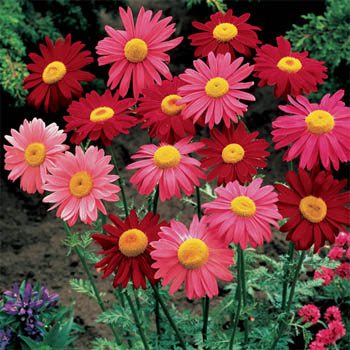
FS505 Giant Painted Daisies ( Tanacetum )
Big 2-3" daisy flowers on long stems reaching 18" tall. Easy to raise and makes excellent cut flowers. Also known as Pyrethum.
Painted Daisies are old-fashioned perennials that have always been popular as cut flowers.
Foliage is bright green and ferny, with upright stems bearing loads of fluffy double daisies, in shades of white, pink or crimson red.
Remove faded flower to encourage more buds to form. Plants may be trimmed hard after blooming to rejuvenate the foliage. Easily divided in spring or fall. These are a nice addition to any sunny border, and also useful in containers or tubs.
For zones 3-7. Grows about 18 inches tall.
Painted Daisies are old-fashioned perennials that have always been popular as cut flowers.
Foliage is bright green and ferny, with upright stems bearing loads of fluffy double daisies, in shades of white, pink or crimson red.
Remove faded flower to encourage more buds to form. Plants may be trimmed hard after blooming to rejuvenate the foliage. Easily divided in spring or fall. These are a nice addition to any sunny border, and also useful in containers or tubs.
For zones 3-7. Grows about 18 inches tall.
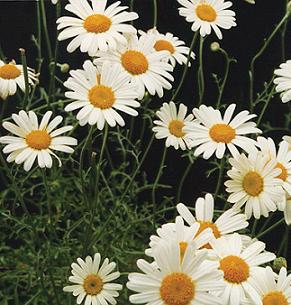
D1751 Pyrethrum Plant ( Chrysanthemum )
Also known as Tanacetum cinerariifolium. An amazing and beautiful plant grown throughout the world, it is hardy to zone 4 in the USA, makes a wonderful flower bed plant or container plant.
A beautiful daisy that is hardy and blooms throughout the spring and summer. The dried flowers are used to make probably the best natural pesticide available. Simply drying the flowers and making a dust or spray is a great way to control insect pests.
The plant is economically important as a natural source of insecticide. The flowers are pulverized and the active components, called pyrethrins, contained in the seed cases, are extracted and sold in the form of an oleoresin. This is applied as a suspension in water or oil, or as a powder.
Pyrethrum insecticide is one of the most widely used natural insecticides in existence. Pyrethrins work as a contact insecticide, the insect only has to be touched by the substance for it to take effect. When not present in amounts fatal to insects, they still appear to have an insect repellent effect. It will inhibit the biting reflex in female mosquitoes. Crucially, although pyrethrum acts quickly on insect pests, it is relatively non-toxic to humans and warm-blooded animals.
Pyrethrins are not persistent, being biodegradable and also decompose easily on exposure to light. They are considered to be amongst the safest insecticides for use around food.
An on-line resource for making your own pyrethrum at home. It is so easy to do!
A beautiful daisy that is hardy and blooms throughout the spring and summer. The dried flowers are used to make probably the best natural pesticide available. Simply drying the flowers and making a dust or spray is a great way to control insect pests.
The plant is economically important as a natural source of insecticide. The flowers are pulverized and the active components, called pyrethrins, contained in the seed cases, are extracted and sold in the form of an oleoresin. This is applied as a suspension in water or oil, or as a powder.
Pyrethrum insecticide is one of the most widely used natural insecticides in existence. Pyrethrins work as a contact insecticide, the insect only has to be touched by the substance for it to take effect. When not present in amounts fatal to insects, they still appear to have an insect repellent effect. It will inhibit the biting reflex in female mosquitoes. Crucially, although pyrethrum acts quickly on insect pests, it is relatively non-toxic to humans and warm-blooded animals.
Pyrethrins are not persistent, being biodegradable and also decompose easily on exposure to light. They are considered to be amongst the safest insecticides for use around food.
An on-line resource for making your own pyrethrum at home. It is so easy to do!
Sowing: Sow late winter to late Spring (Feb to May) or Late Summer to Autumn ( August to October) Sow pyrethrum seeds in pots indoors or sow directly where they are to flower in a prepared bed in late spring once all danger of frost has passed. For the best results, choose a planting location that receives full sun and has very well-drained soil of average fertility.
For sowing indoors, sow in pots or trays containing good seed compost. Barely cover the seeds with a fine sprinkling of compost and make sure the compost is kept moist but not wet. Germination usually takes 30 to 60 days at 55°F.
Transplant the indoor seedlings when large enough to handle into pots and grow on. Plant them out into their permanent positions in late spring or early summer, after the last expected frosts. Space 12 inches apart. Water regularly for the first two weeks of growth for container-grown plants to allow them time to become established.
Increase watering during times of drought or extreme heat.
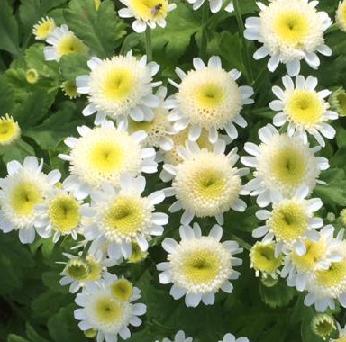
IP324 White Star ( Tanacetum )
A compact habit growing only 8 inches tall and small fully double blooms make this an excellent choice for old-fashioned border edges. Lovely in fresh or dry bouquets and arrangements, attracts butterflies and bees, and is drought tolerant. Good container plant and for edging. Can be grown as an annual, or perennial in zones 5-9.

